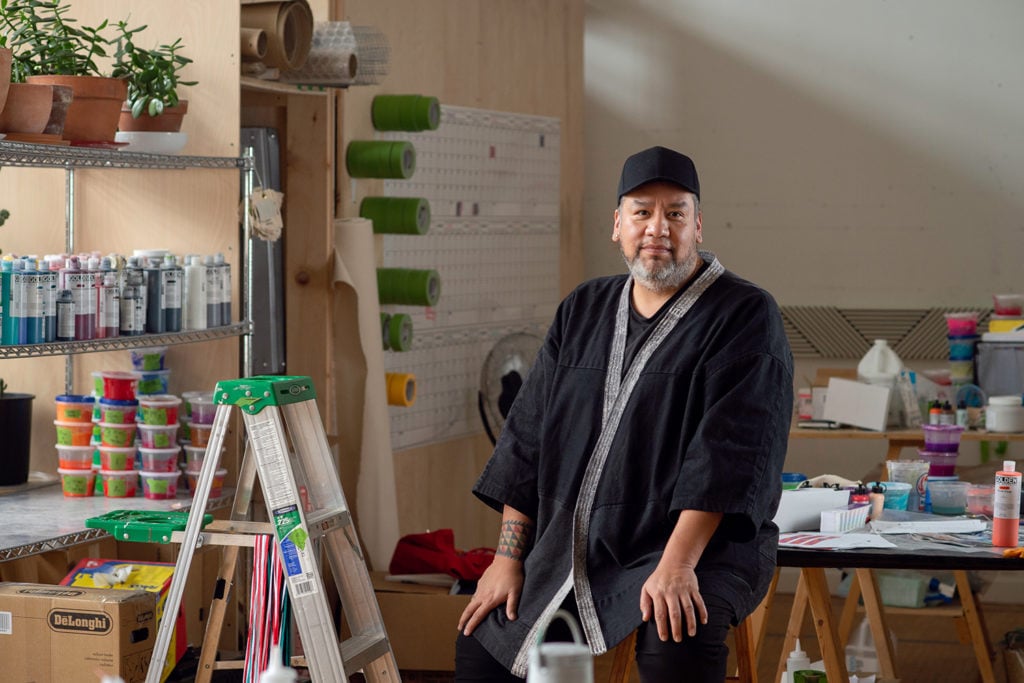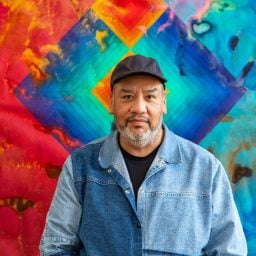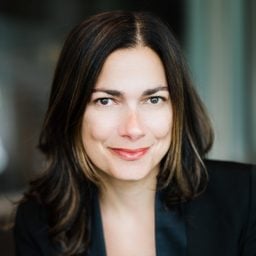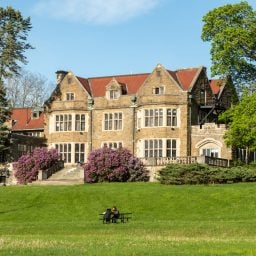In the light-filled gymnasium of an old schoolhouse in Hudson, New York, a punching bag adorned with neon beads and tassels hangs near a long-forgotten basketball hoop. A totemic sculpture stands in a carpeted classroom and masks are strung through the woodshop.
This is the studio of Jeffrey Gibson, a Choctaw-Cherokee artist known for his signature hybrid of Native American iconography and materials with late-capitalist aesthetics. It’s Indigenous Futurism, to borrow a label posited by Anishinaabe writer Grace L. Dillon: the regalia of pow-wows meets that of ‘90s rave culture, while quilted tapestries are patterned with Op art.
“People think I know what’s going to happen when I produce a new body of work, but I don’t,” Gibson says, sitting at a desk in what was, presumably, the principal’s office. “For someone who works across as many materials and formats as I do, I have no idea how something is going to resonate when I’m producing it. I just don’t. And that’s okay.”
Gibson, a professor at Bard College, purchased the schoolhouse back in 2016. A team of roughly a dozen assistants are stationed throughout the building, each working on different projects dreamed up by the artist. They talk about Gibson less like a boss and more like a father figure—or maybe a fun uncle. And there’s plenty to keep them busy.
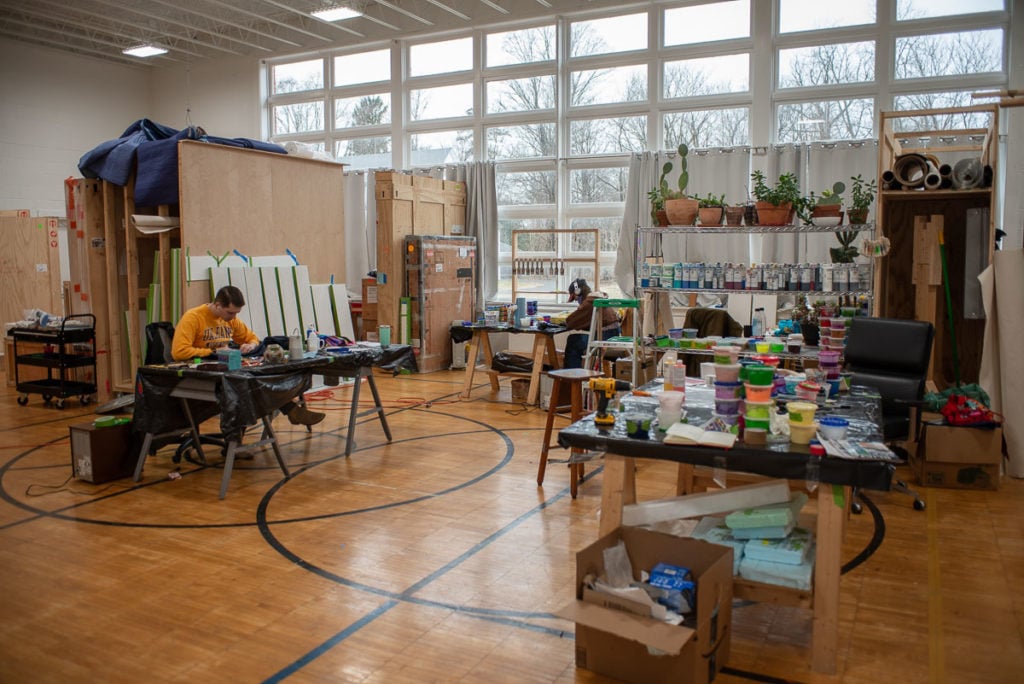
Gibson’s studio. Photo: Taylor Dafoe.
Over the past few years, Gibson has had separate solo shows at more than a half dozen museums, including a major mid-career survey that traveled to four venues. He was awarded a MacArthur genius grant, an honorary doctorate, and included in the 2019 Whitney Biennial. Today, his calendar is busier than ever.
The artist, who turns 48 this month, currently has a show at the Brooklyn Museum and a series of works on billboards in Times Square. And over the course of the next year, he will open exhibitions at Roberts Projects in Los Angeles and Sikkema Jenkins in New York and will be included in shows at the Parrish Museum, Socrates Sculpture Park, and several other venues.
Yet 10 years ago, Gibson considered giving up art altogether.
Shortly after the opening of his exhibition at the Brooklyn Museum, Gibson invited Artnet News to his studio to talk about the evolution of his practice and the critical juncture in his career when he went from nearly quitting the art world, to being one of its most buzzed-about artists.

An assistant working in Gibson’s studio. Photo: Taylor Dafoe.
You’ve lived and worked in this area since 2012. What was your studio like before that?
I had a small studio space in the Brooklyn Navy Yard. It was less than 300 square feet. You could probably fit two and a half of them in this room.
Around 2010, I went out to San Francisco to teach at the California College of the Arts. From there, my husband and I really didn’t know what we were going to do. We were looking for change, so we moved to France for about half a year. Then we decided we wanted to come back to the East Coast, but not necessarily to New York City. I got the position at Bard, and we were just like, “Well, let’s just give it a go. We’ll move to Hudson and we’ll see how it goes.” For the first five years, it was a check-in. “What do we think? Is this someplace we could stay?” Then it just kind of unfolded from there. We had kids and bought our house and bought this building. It seems to be the right mix of things for us.
I imagine the move had a big impact on your practice, if for no other reason than the immense difference in size and space.
It did. Living in Brooklyn at the time, I kind of felt like I was experiencing what I could imagine experiencing there for another 20 years. You show your work, you might sell some of it every now and again, you might get a grant occasionally. But really, I felt like we had hit a sort of ceiling of potential due to the cost of living, the limited space, all of that sort of stuff. I also wanted to minimize distractions. I felt like, with the development of myself as an artist, I really needed space—both physical space and mental space—to be able to think through ideas and develop them. Voices get in my head very easily. I just had to remove them for myself.
New York City tends to hold people in a somewhat infantile place. Moving up here, immediately it was like someone turned on the switch where you get to move into the rest of your life. I think that has, for one, made me a happier, calmer person. It’s also given me a perspective to think in a much larger way. I think the work will follow that. It is following that.
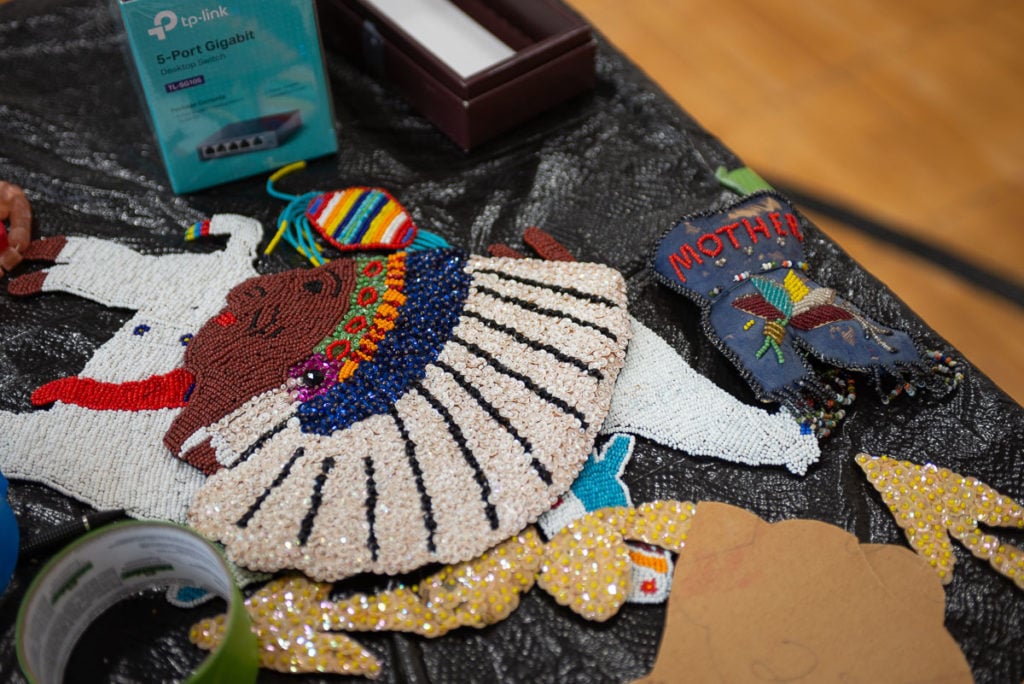
Details from Gibson’s studio. Photo: Taylor Dafoe.
In its invocation of craft and traditional forms of art-making, your work emits a sense of intimacy—it feels like it was labored over by the artist’s own hand. How do you maintain that feeling while working with a team of people?
It’s really what necessitates having a team. I realized early on that I’m drawn to handcrafted objects. There’s an intimacy that’s triggered just by looking at them. There’s something about the labor and the detail that is seductive. I knew that I couldn’t put out only six pieces a year and expect to accomplish what I wanted to. So that’s where the studio team started being assembled.
I sought people who enjoy handcraft and who understand the meditative quality of it. I don’t want to overemphasize how much craft is connected to trauma and healing, but you find handcraft in a lot of situations where people need to refocus and find transformation. Doing it, you really build the skill of being able to conceive, initiate, and complete. That was something that I was drawn to and would speak about. Especially when I would visit more traditional makers in native communities, people’s attachment to sewing, beading, quell work, any of those things—it really is a meditative, cathartic process of making something. I wouldn’t say that’s necessarily me wholly, but it was at the beginning and now it’s transformed into something else. Even when I think about concepts now, I think about the craft of concepts.
When I first started assembling the team of people who work here, I talked to them very clearly about the goals of the studio and one of them was that I can’t be sitting there doing beadwork work anymore because I need to be able to do research and experiment. I need to be able to fail. By this point, the studio team is very skilled and our communication is remarkably fluid.
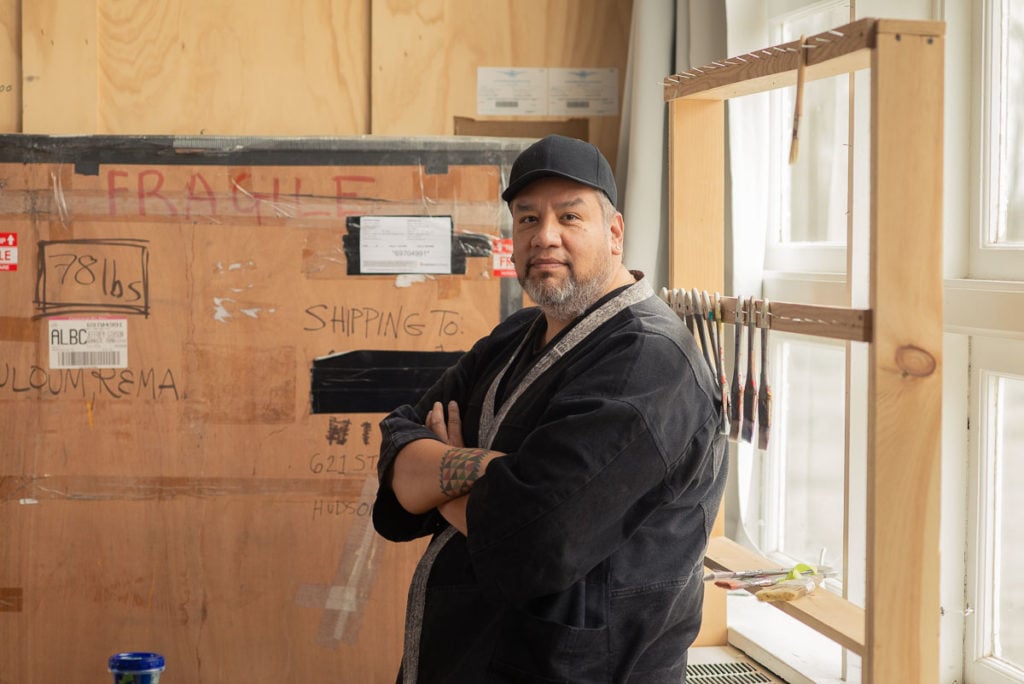
Jeffrey Gibson in his studio, 2020. Photo: Taylor Dafoe.
There was a time when you considered giving up your practice altogether, right?
Yes, in 2010 and ’11, I was trying to decide if I wanted to continue being an artist. I was just fed up. When we were in Europe and when I was in San Francisco, I did not allow studio visits. I was really trying to discipline myself not to consider what the art world wanted but instead think about what it was that I wanted to make. What was it that I thought was important to exist?
Then, while traveling in Europe, I got a call from Lia Gangitano at Participant gallery. I always thought it was a brilliant space and that she is amazing. And I said to myself, “If I was ever going to do a solo show, that’s where I would want to do it.” So when she called and said I’d like to do something together, I was thrilled. And Matthew Dipple, who then ran a space called American Contemporary, also contacted me, and so we ended up doing two shows that opened on the same night in early 2012. It really was the first time, in my opinion, the work really resonated with an audience. They finally got it. They got the mix of materials, the mix of narratives. And there was a really great review that came out. So after wanting to walk away from being an artist, it was the exhibition that showed me it was possible to work with the art world and talk to its audiences.
Do you feel that was more to do with the evolution of your practice or the evolution of the audience?
I don’t really know what the circumstances were that allowed that to happen, but it did. My training is as a painter and my love is process-based abstraction. To try to combine narratives about Native American material culture and history into that kind of abstraction—no one has ever been able to show me how to do that, nor have I ever really seen it. So I think when I exited New York for that period, that’s what I was figuring out. One of the realizations I came to was that I have to use language that people can comprehend. If it’s so subjective, it may be great and cathartic for myself, but it won’t be legible to others.

Details from Gibson’s studio. Photo: Taylor Dafoe.
Do you ever feel pressured to perform identity politics in your work? Or do you get frustrated that people put that narrative onto it?
I know that people will put it on it. I just take that as a given circumstance. I learned that growing up. You honestly cannot be a brown person in a white environment and not be asked, “Where are you from? What are you? Where’s your family from?” People have thought that I strategically use the label Native American. They’ll ask me, “Why would you identify as a Native artist?” And I say, “Because I’m always going to get asked.” And I truly am drawn, for instance, to beadwork and quilt work and that kind of design and material use. The problem I had when I was painting was that I was somehow translating those very specific references into abstraction, and in that translation, the whole narrative was lost for anyone who wasn’t with me. So that’s when I started asking okay, “How can you trim down the references and be more direct with what you’re talking about?”
It’s about being very aware of the circumstances that art exists in. It goes back to the communication thing. I want people to pull things out of the work. There’s an openness to a lot of the texts that I use that I think people can project themselves and their own experiences onto, which is the way that pop music works and one of the reasons it sticks around. There’s something about it that makes it feel like it’s just about you in that moment. That’s one of the things that I really shoot for. And I’ve always counted on the fact that there have to be more people like me in the world. Yes, I’m unique, but I’m not so unique that other people are not like me. We all experience hybridity. We all experience vulnerability, love, fear.
See more photos from Gibson’s studio below.
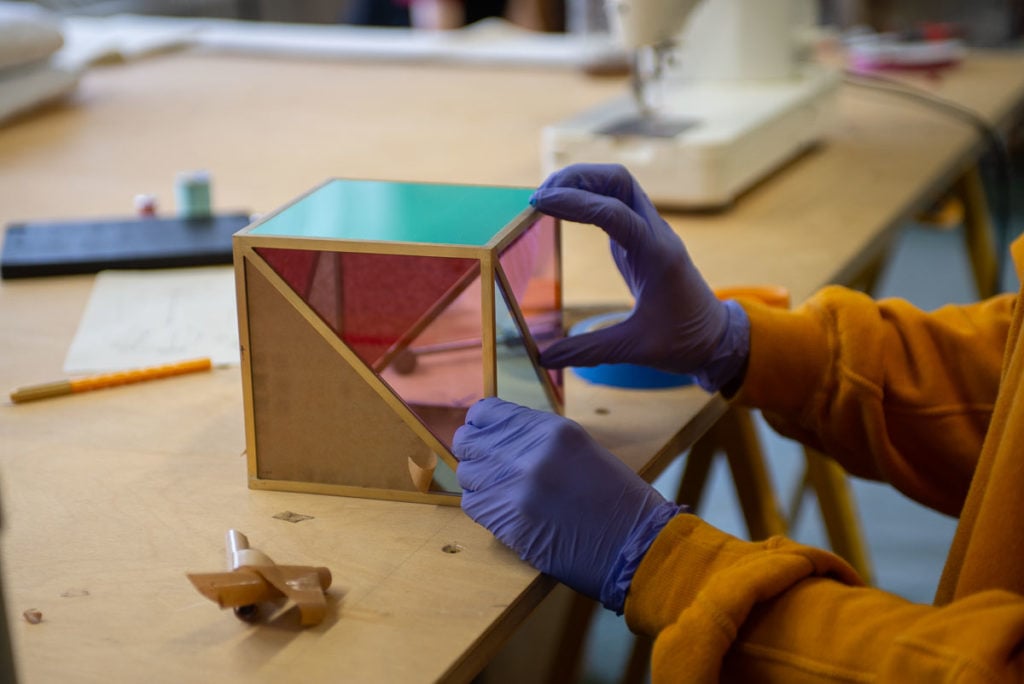
An assistant working in Gibson’s studio. Photo: Taylor Dafoe.
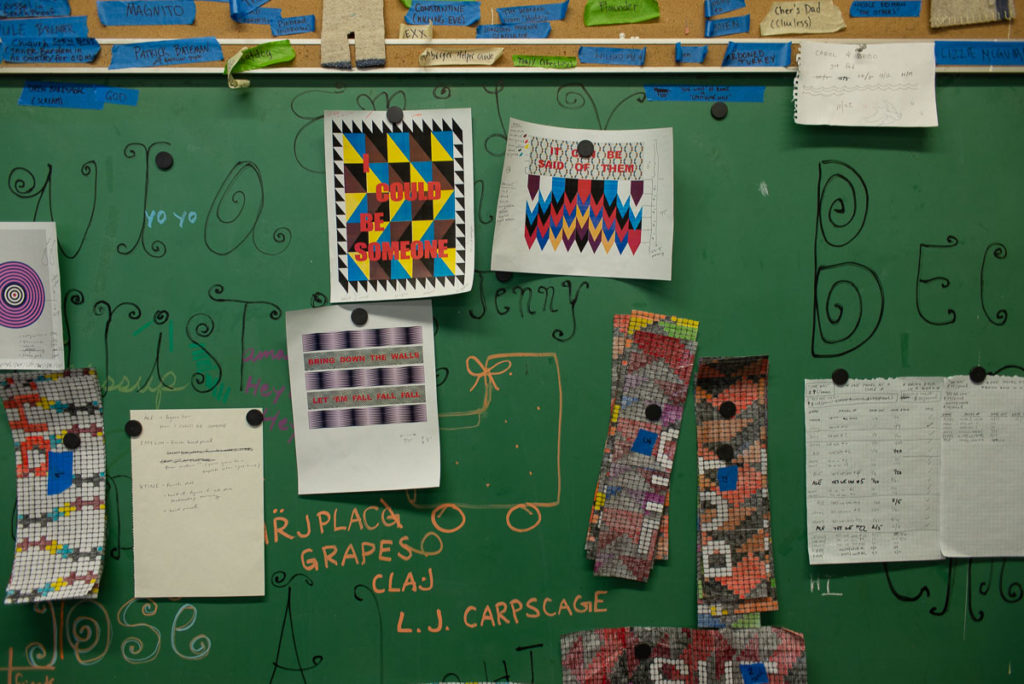
Details from Gibson’s studio. Photo: Taylor Dafoe.
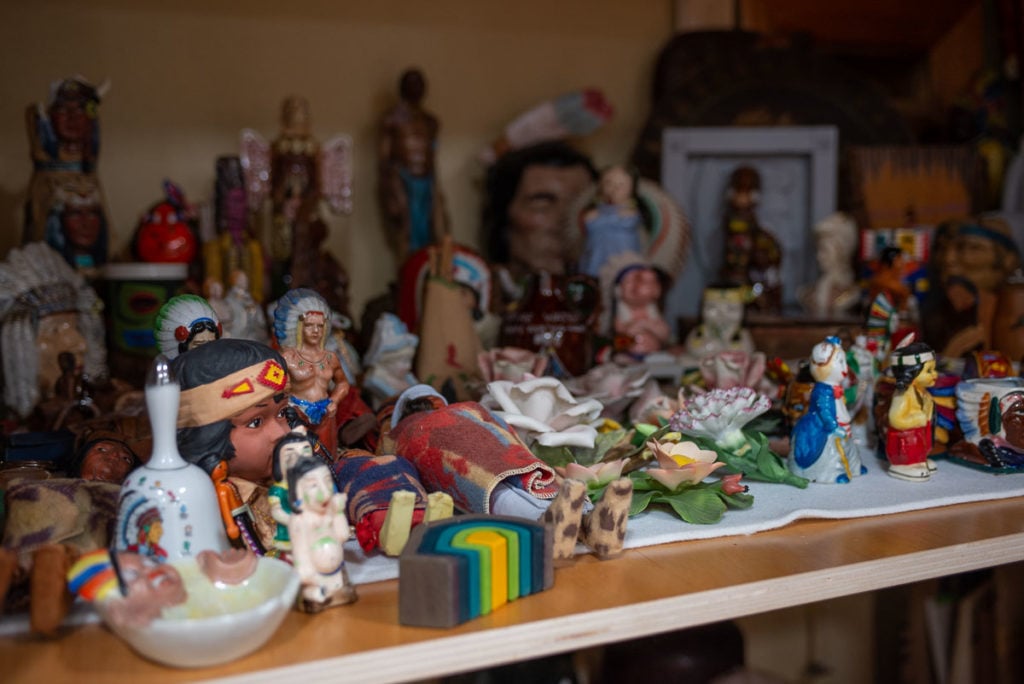
Details from Gibson’s studio. Photo: Taylor Dafoe.
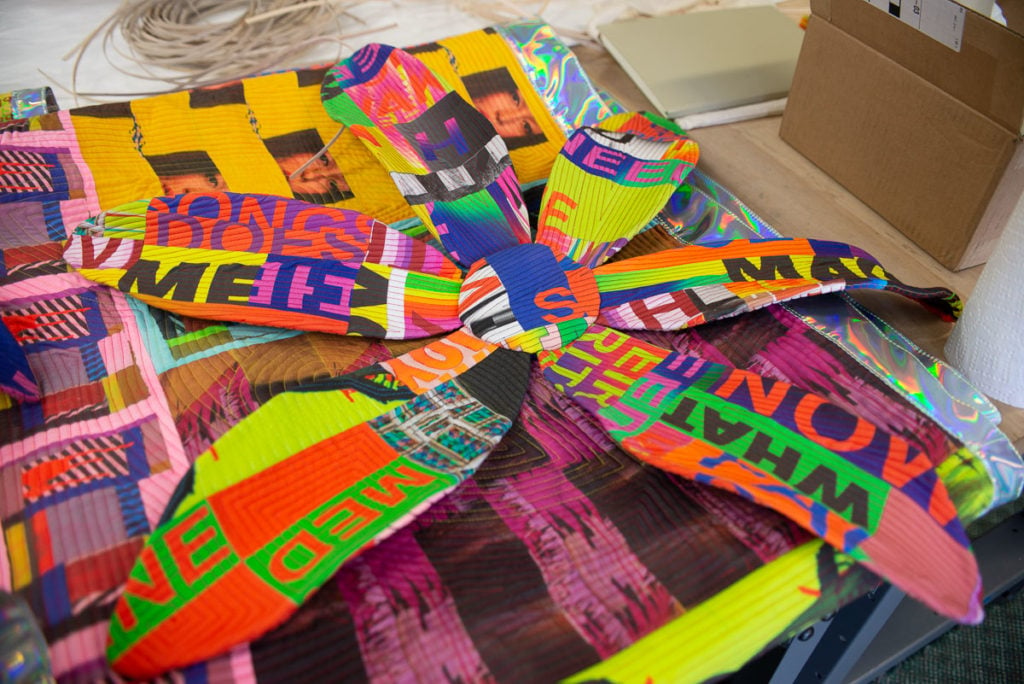
Details from Gibson’s studio. Photo: Taylor Dafoe.
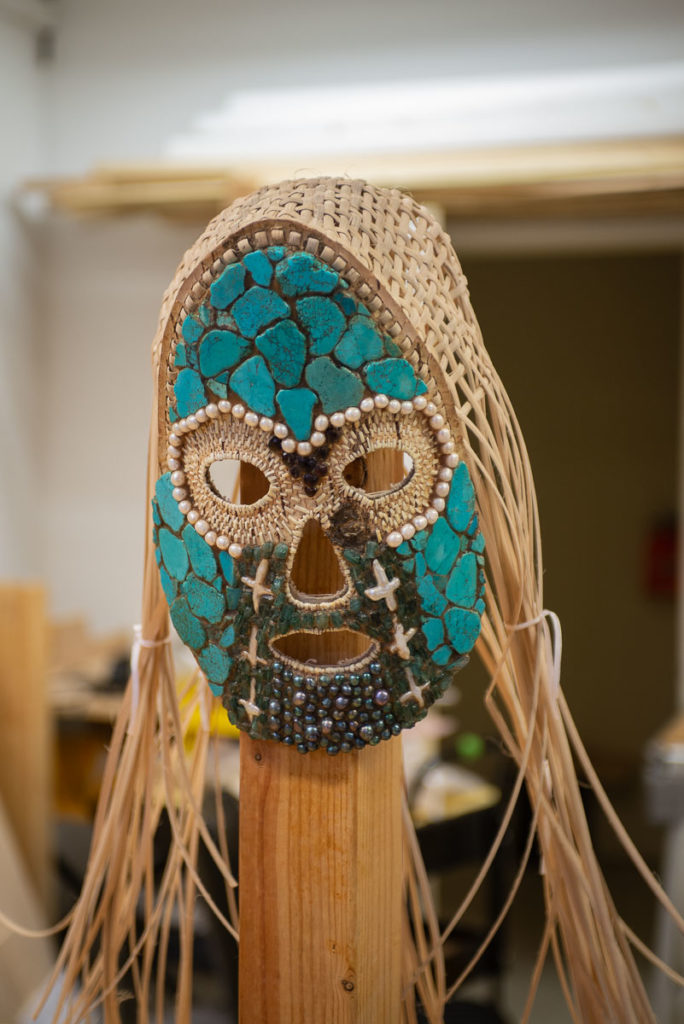
Details from Gibson’s studio. Photo: Taylor Dafoe.
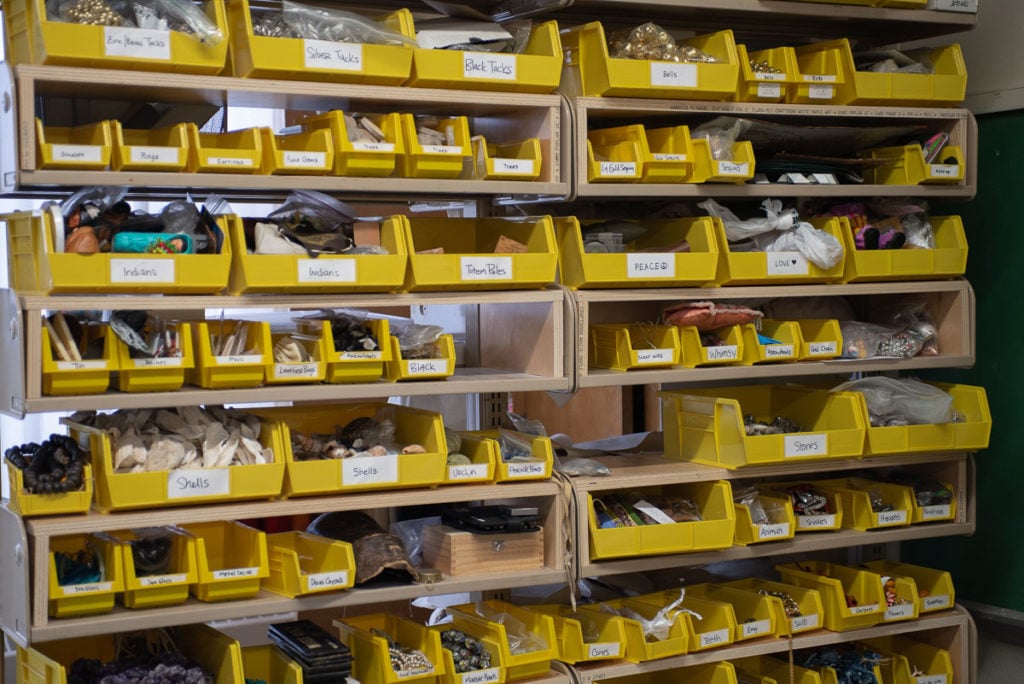
Details from Gibson’s studio. Photo: Taylor Dafoe.
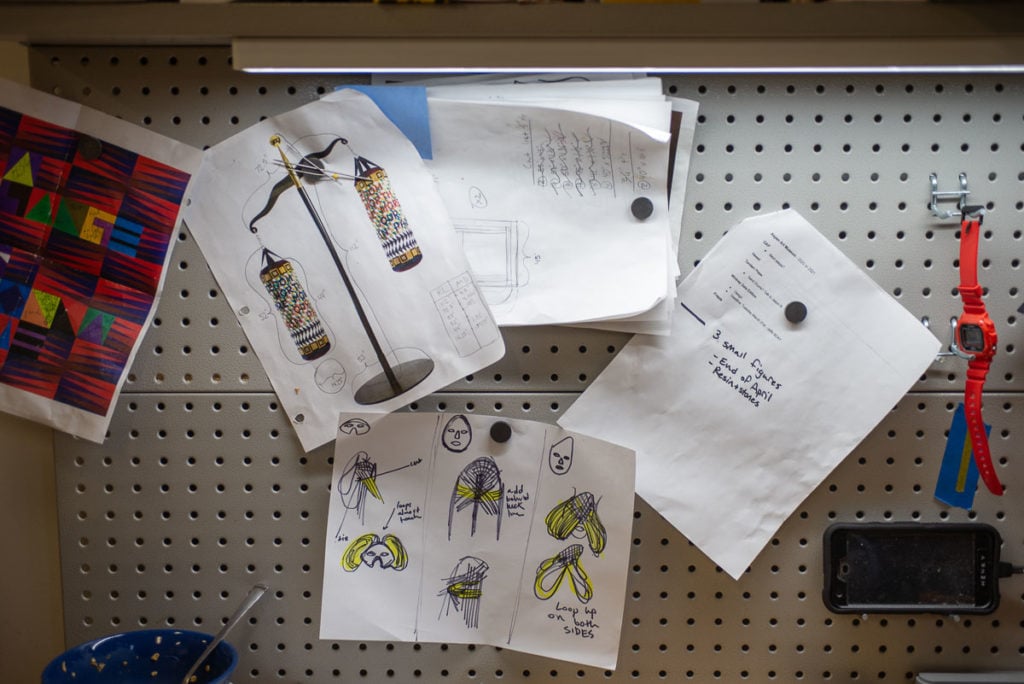
Details from Gibson’s studio. Photo: Taylor Dafoe.
